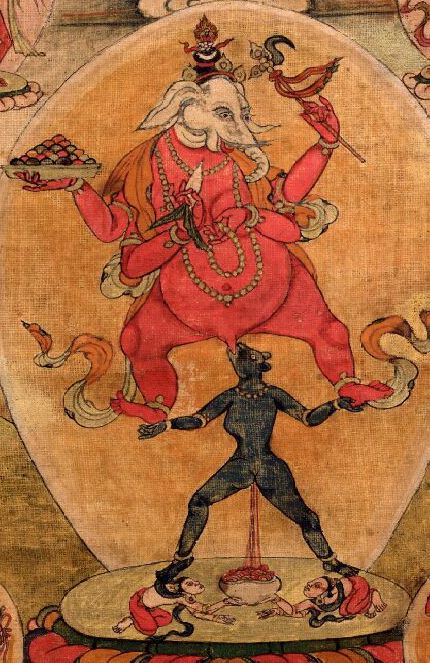Buddhist practice and Buddhist art have been inseparable in the Himalayas ever since Buddhism arrived to the region in the eighth century. But for the casual observer it can be difficult to make sense of the complex iconography. Not to worry—Himalayan art scholar Jeff Watt is here to help. In this “Himalayan Buddhist Art 101” series, Jeff is making sense of this rich artistic tradition by presenting weekly images from the Himalayan Art Resources archives and explaining their roles in the Buddhist tradition.
Part 1: Dorje Shugden
Part 2: The Svastika
Controversial Art, Part 3: Ithyphallic Deities

To the layman, “tantra” and “tantric” connote sex, and “tantric art” evokes sexual imagery. Most sexual imagery in Himalayan Buddhist art, however, is actually quite tame, with only the suggestion of sexual activity given by either seated or standing couples in warm embraces. (Granted, the couples are naked except for wisps of clothing or bone ornaments designed to conceal nothing.) But embracing couples, one of the most common imageries, are far less controversial compared with the ithyphallic [having an erect penis] depictions of solitary male deities and dancing Vajrayogini figures.

There are five main examples of ithyphallic deities: Vajrabhairava, Yama Dharmaraja, Black Jambhala, Ganapati, and Mahadeva (Shiva). Each is generally depicted alone, though Mahadeva is often flanked by the consort Uma Devi; some paintings depict the deity holding his erect member in his left hand. Ganapati, a deity of peculiar persuasion, is occasionally befriended by a female monkey while in the aroused state.
These five examples of ithyphallic deities can be catalogued by figurative appearance as either wrathful or semi-peaceful/semi-wrathful. According to function and the classification of the Four Tantric Activities of Vajrayana Buddhism, these deities all perform either “powerful” or “wrathful” activities. The aroused state depicts both literally and symbolically an intense desire and passion to accomplish a specific task. In the case of Black Jambhala and Ganapati, the focus is on gaining wealth; for the red forms of Ganapati and Mahadeva, it is wealth and power; and for the meditational deity Vajrabhairava and the special protector Yama Dharmaraja, the symbolism relates to the intensity of their wrathfulness in overcoming ego and obstacles to reaching enlightenment.

One form of Ganapati known as Ragavajra, introduced to Tibet by Atisha in the 11th century, would likely be classified x-rated by most Western standards. In this example Ganapati is depicted dallying with a monkey, which is performing fellatio on him. The symbolism here is harder to explain and involves some understanding of tantric physiology and theory…
The idea of deity couples in sexual embrace is certainly alluring—and, to the prudish layman, possibly objectionable—but the reality of the imagery is surely disappointing compared to the exaggerated depictions of ithyphallic deities.
Thank you for subscribing to Tricycle! As a nonprofit, we depend on readers like you to keep Buddhist teachings and practices widely available.